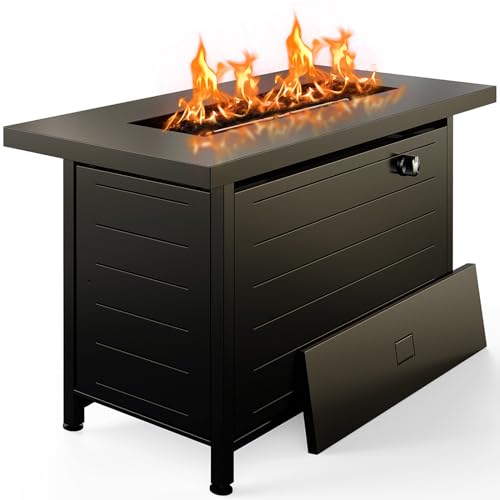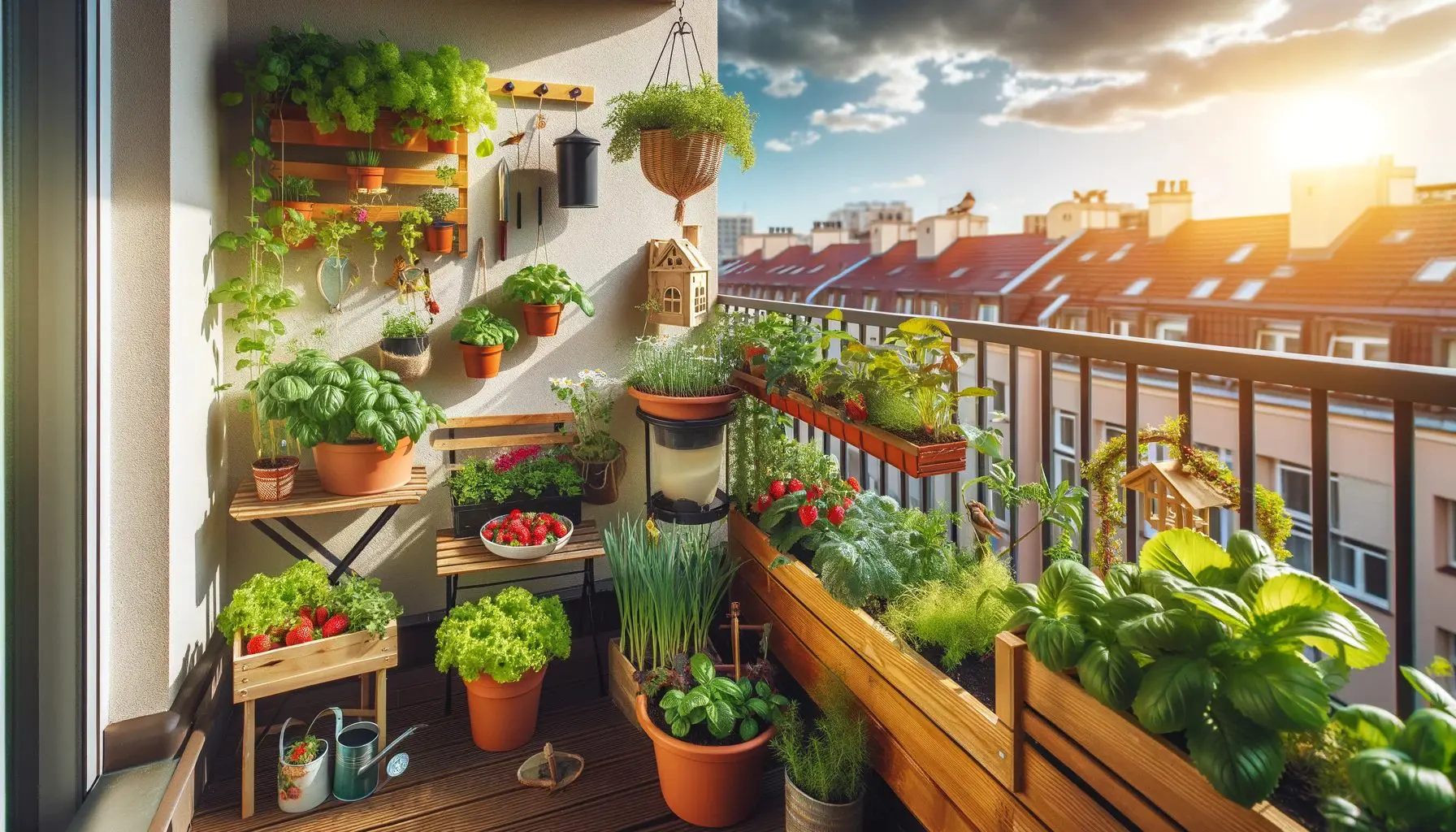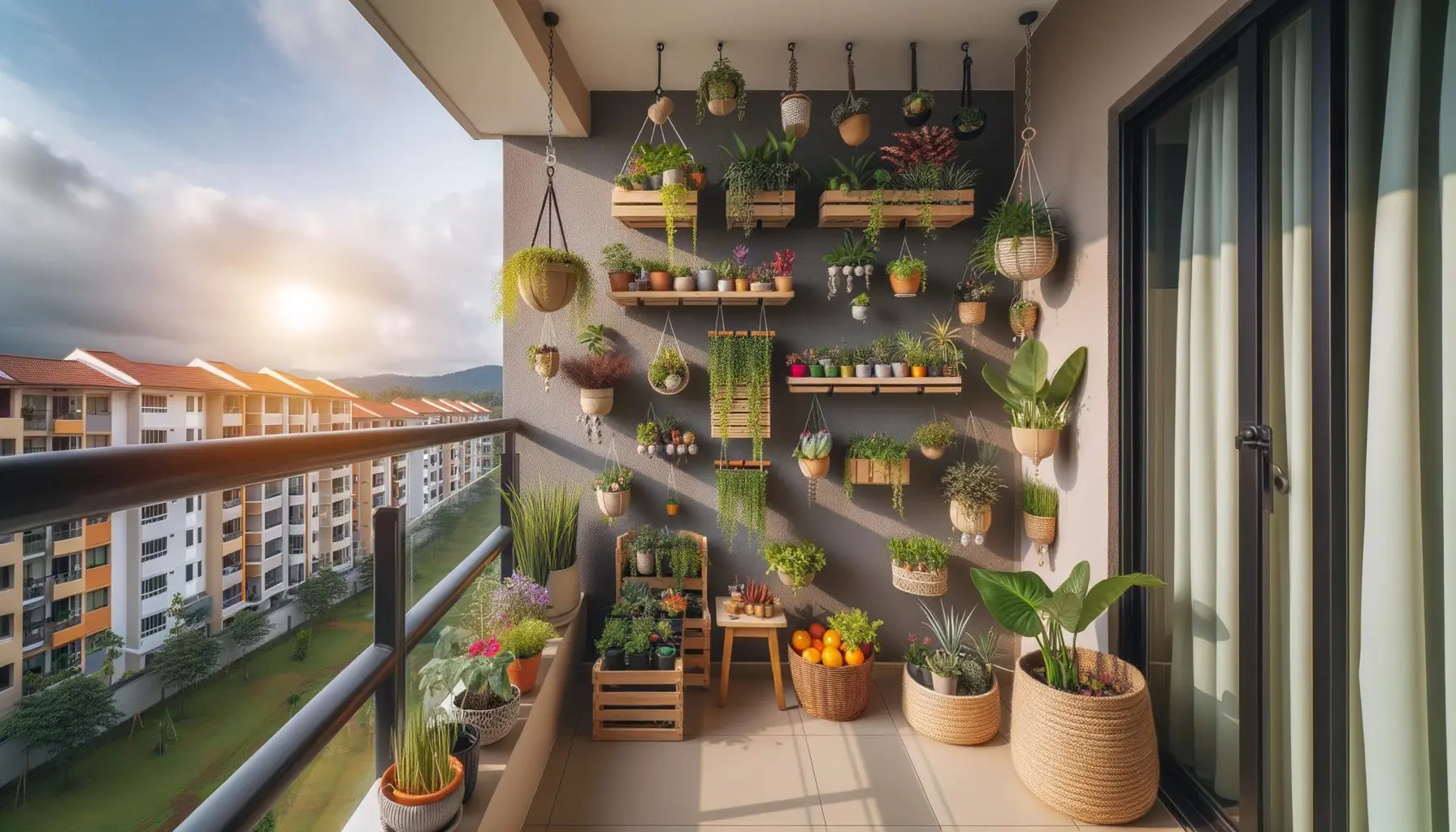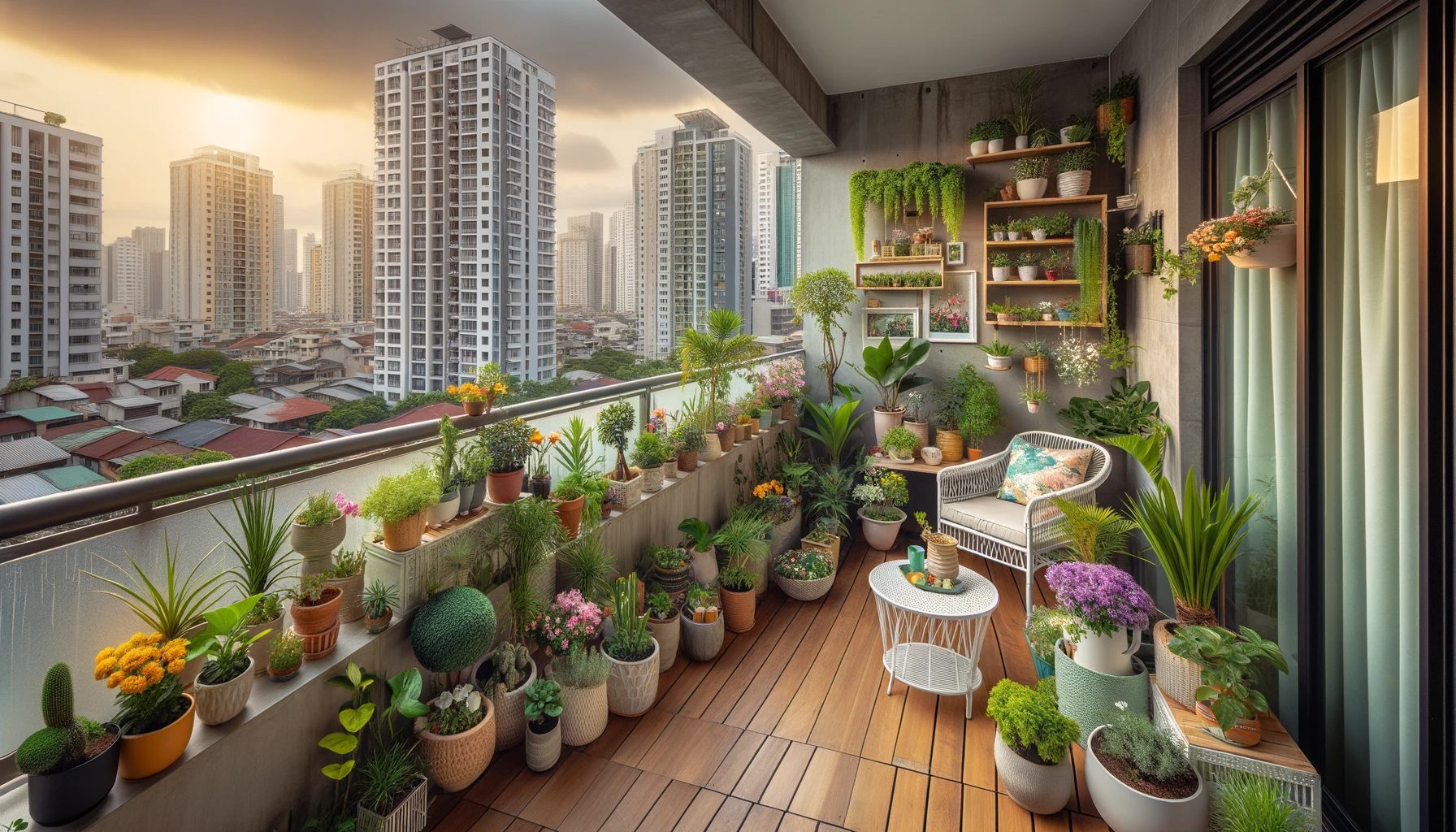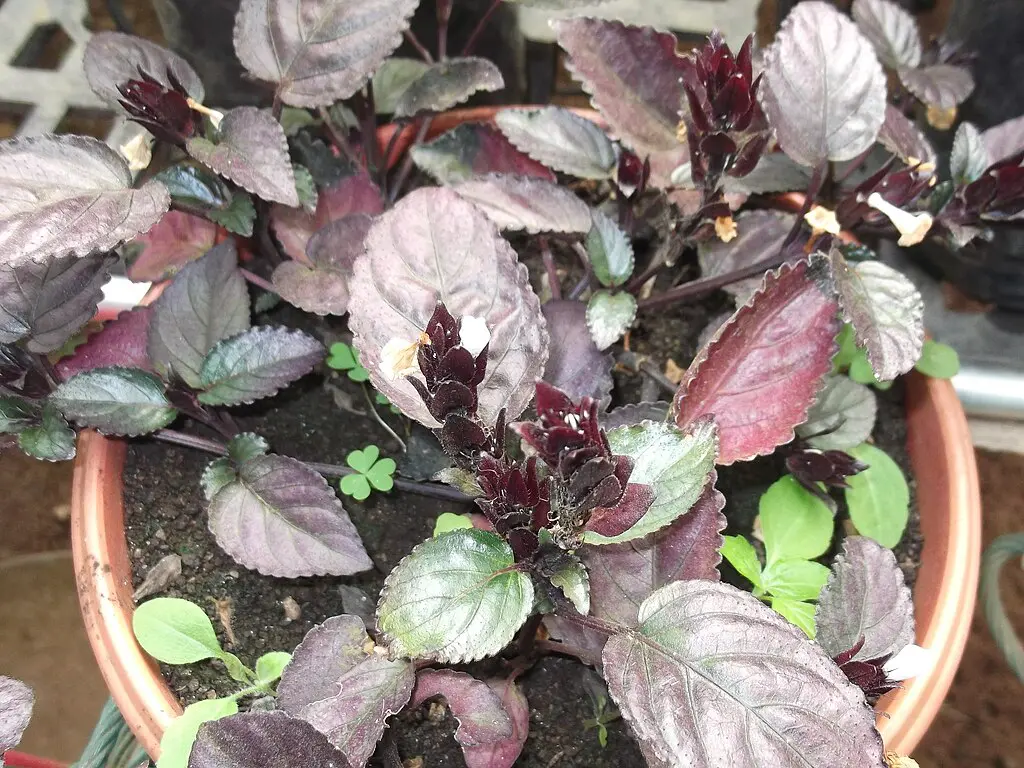This post contains affiliate links. If you buy something from one of our links we may earn a commission. Thanks
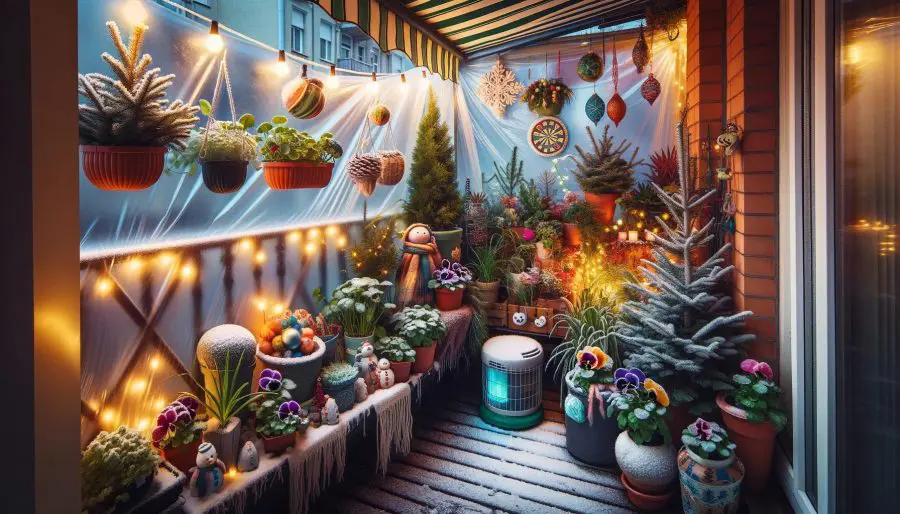
Discover the joys of balcony gardening in winter! Our guide offers practical tips for thriving plants and cozy spaces, making winter gardening a delight.
Winter Balcony Gardening Key Takeaways:
- Balcony gardening in winter involves protecting plants from frost, using insulating materials, and choosing cold-hardy varieties.
- It’s about creating a warm, inviting space with lighting and textiles, ensuring a vibrant and enjoyable balcony garden throughout the colder months.
Laying the Foundation for Winter Balcony Gardening
Welcome to the world of balcony gardening in winter! This season brings unique opportunities to transform your balcony into a frost-resistant oasis.
Whether you’re a seasoned gardener or just starting out, join us as we explore how to keep your plants thriving and your outdoor space inviting during the chillier months.
Introduction to Balcony Gardening in Winter
Winter balcony gardening transforms your outdoor space into a resilient, picturesque spot.
This guide helps you turn your balcony into a frost-resistant garden, ensuring vibrancy even in the coldest months.
Balcony Gardening in Winter
As winter nears, it’s crucial to prepare your balcony. This involves choosing winter-hardy plants, insulating containers, and protecting against harsh elements.
We’ll show you how to winter-proof your balcony for a lively garden all season.
Insulating Pots and Planters:
Protecting your plants’ roots from the cold is essential for their survival during winter.
Insulation methods such as wrapping pots in bubble wrap or burlap are effective in providing a barrier against freezing temperatures.
This is especially important for ceramic or terracotta pots that can crack in the cold.
Elevating pots off the ground is another crucial step. You can use pot feet or even a simple wooden board.
This not only prevents water from pooling beneath the pots, which can lead to root rot but also minimizes the risk of frost damage from cold surfaces.
Remember, the goal is to keep the root zone slightly warmer than the surrounding air.
Choosing the Right Plants for Winter:
Selecting plants that can withstand winter’s harsh conditions is vital for a thriving balcony garden.
Frost-resistant plants like pansies, which offer a splash of color even in chilly weather, are ideal.
Evergreens such as conifers or boxwoods maintain greenery and structure throughout the season.
Hardy herbs like rosemary and thyme can also endure colder temperatures and provide fresh flavors for your winter dishes.
When choosing plants, consider their light and water requirements, ensuring they match your balcony’s winter conditions.
Remember, some plants might be dormant in winter but will spring back to life in warmer weather.
Weatherproofing Furniture and Accessories:
Winterizing your balcony involves more than just caring for plants; it also means adapting your furniture and accessories for the colder months.
Opt for weather-resistant furniture made from materials like metal, treated wood, or all-weather wicker.
These can withstand the fluctuations in temperature and moisture levels typical of winter.
If you have delicate items or textiles, consider storing them indoors or in a waterproof storage box.
For added protection, use covers for your furniture and grills. This not only extends their lifespan but also keeps your balcony neat and ready for use.
Additionally, adding a few outdoor rugs made from synthetic materials can provide comfort underfoot and contribute to the cozy aesthetic of your winter balcony garden.
Creating a Cozy Winter Balcony Atmosphere
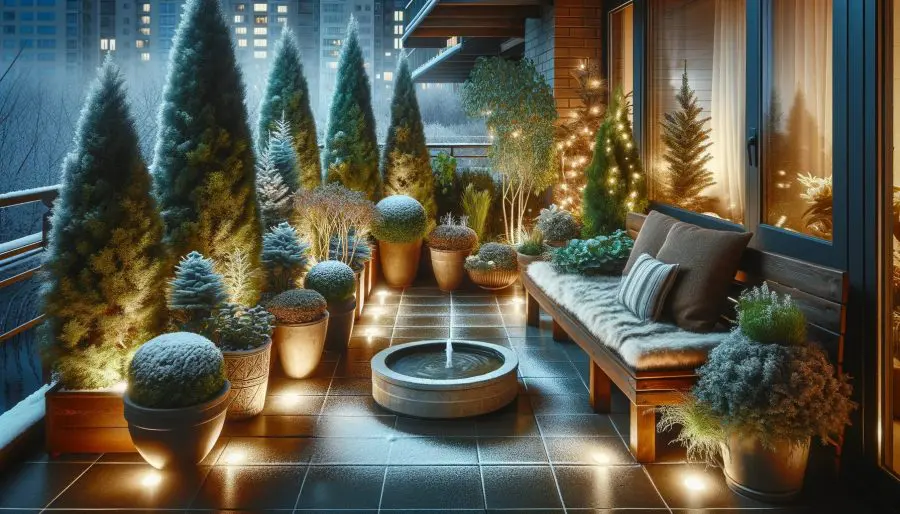
Make your balcony a cozy retreat. We’ll explore ways to add warmth and charm, from strategic lighting to decorative touches, creating an inviting winter haven.
Lighting and Decorations for Ambiance:
Creating the right ambiance on your winter balcony is key to enjoying it even in the colder months.
String lights are a simple yet effective way to add a warm, inviting glow.
They can be draped along the railing, around plants, or even across the ceiling to create a starry effect.
Lanterns, whether hanging or tabletop, also contribute to a cozy atmosphere and can be used with candles or LED lights for safety.
When it comes to seasonal decorations, think beyond traditional holiday decor.
Use winter-themed items like snowflake ornaments, icicle-inspired decorations, or even a small, artificial snow-covered tree to enhance the winter feel.
The key is to create a space that feels magical and inviting, a place where you can enjoy the beauty of winter from the comfort of your home.
Adding Warmth with Textiles:
Textiles are an excellent way to add warmth and comfort to your winter balcony.
Outdoor rugs can define the space and make it feel more like an extension of your indoor living area.
Choose materials designed for outdoor use, capable of withstanding damp conditions, and easy to clean.
Throws and cushions add not only warmth but also a splash of color and texture.
Opt for fabrics that are moisture-resistant and quick-drying. Faux fur, fleece, and outdoor-specific fabrics are great choices.
These textiles not only provide physical warmth but also contribute to a snug and inviting aesthetic, making your balcony an ideal place to relax with a hot drink and enjoy the outdoor scenery.
Incorporating Fire Elements for Heat:
A fire element can transform your balcony into a warm and inviting space.
If your balcony space and regulations allow, consider adding a chiminea or a tabletop fireplace.
These not only provide warmth but also act as a stunning focal point. Ensure that any fire element you choose is safe for use on a balcony and is placed on a non-flammable surface.
Portable fire pits or electric heaters designed for outdoor use are also good options.
Always follow safety guidelines, keep flammable materials away and never leave the fire unattended.
The warmth and light from a fire element can make your winter balcony garden a delightful retreat, perfect for chilly evenings.
Nurturing and Enjoying Your Winter Balcony Garden
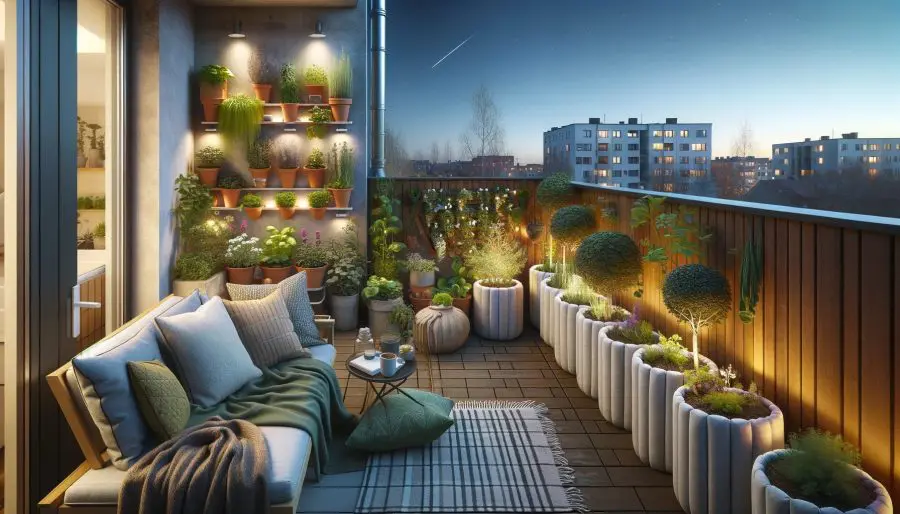
Plant Care During Winter
Caring for plants in winter requires specific strategies for protection and maintenance. In this section, we’ll delve into essential tips to keep your balcony plants thriving, even in the colder months.
Watering and Feeding in Cold Weather:
During winter, plants’ water needs decrease significantly, but it’s still crucial to keep the soil from drying out completely.
Water your plants less frequently than you would in warmer months, using lukewarm water to avoid shocking their roots.
Early morning is the best time to water, allowing the plants to absorb moisture before the colder night temperatures.
Additionally, use a winter-friendly fertilizer, preferably one with lower nitrogen content and higher potassium and phosphorus, to help strengthen the plants against cold stress.
Remember, overwatering is a common mistake in winter, leading to root rot, so ensure the soil is just slightly moist.
Protecting Plants from Frost:
Frost can be deadly for many plants. To protect them, use frost cloth or burlap to cover them, especially during the night when temperatures drop significantly.
These covers should be removed during the day to allow sunlight and air circulation.
Clustering your plants together can also help, as they create a microclimate that retains heat.
Placing plants near the walls of your building can provide additional warmth, as buildings often retain heat.
For potted plants, moving them indoors or to a sheltered area during extreme cold snaps can be a lifesaver.
Pruning and Maintenance Tips:
Winter is an ideal time for pruning many plant varieties.
Pruning helps remove dead or diseased branches and encourages healthier growth in the spring.
It also allows you to shape your plants and control their size. However, be sure to research your specific plant types, as some plants are best pruned at other times of the year.
Regularly inspect your plants for pests and diseases, as early detection is key to effective treatment.
Some pests are more active in winter, and indoor conditions can promote the spread of certain diseases.
Keeping your plants healthy through regular maintenance is crucial for their survival and flourishing in the winter months.
Winter-Friendly Plants and Flowers
Selecting the right plants is essential for a vibrant winter balcony garden.
Some plants thrive in cold weather, adding color and life to your space even during the chilliest months.
Here, we’ll explore the best options for both aesthetic appeal and resilience.
Best Plants for Winter Balconies:
When choosing plants for your winter balcony, look for those that can withstand colder temperatures. Hellebores, also known as Christmas Roses, are perfect for adding a splash of color during the winter, with their elegant, rose-like blooms in shades of white, green, pink, and purple.
Evergreens like boxwood or dwarf conifers are excellent for adding structure and maintaining a green appearance all year round.
These plants are not only hardy but also versatile in terms of design, fitting into various garden styles from formal to casual.
Incorporating a mix of these plants can create a balanced and visually appealing winter garden.
Flowering Plants to Brighten Winter Days:
To add some color to your winter balcony, consider plants like pansies and violas, which can flower even in snow.
Winter jasmine, with its bright yellow flowers, can bring a cheerful vibe during the dreary winter months.
These plants are not only beautiful but also relatively easy to care for, making them great choices for gardeners of all levels.
They can be planted in pots or hanging baskets, adding a layer of color and liveliness to your balcony.
Evergreens and Perennials for Winter:
Evergreens are the backbone of any winter garden, providing a lush, green backdrop when most other plants have lost their leaves.
In addition to boxwood, consider adding varieties like yew, holly, or arborvitae.
Perennials like ornamental grasses, such as fescue or blue oat grass, offer interesting textures and movement.
Some perennials, like the winter-flowering heather, bring subtle color and texture, enhancing the overall look of your winter balcony.
These plants not only survive but also thrive in colder conditions, ensuring your balcony garden remains vibrant and full of life throughout the winter.
VI. Utilizing Small Spaces Effectively
Maximizing space is crucial in balcony gardening, especially when dealing with limited areas.
Innovative and smart space utilization can transform a small balcony into a lush, productive garden.
We’ll explore several strategies to make the most of your balcony space, focusing on vertical gardening, space-saving furniture, and efficient layout planning.
Vertical Gardening and Hanging Plants:
Vertical gardening is an excellent way to maximize limited space. Utilize wall planters, which can be attached to walls or railings, to grow a variety of plants without taking up valuable floor space.
Hanging baskets are another great option, perfect for trailing plants like ivy or flowers such as petunias.
These can be hung from the ceiling, railing, or wall brackets. Trellises can also be used for climbing plants like clematis or even some vegetables like peas and beans.
This approach not only saves space but also adds a vertical element of interest to your garden, creating a lush, green wall effect.
Compact Furniture and Storage Solutions:
Choosing the right furniture is key to keeping your balcony organized and spacious.
Opt for foldable or stackable chairs and tables, which can be easily stored away when not in use.
Multi-functional furniture, like a bench with built-in storage, is also a great choice.
It provides seating while also offering a place to store gardening tools, pots, and soil.
Wall-mounted shelves or racks can be used to keep gardening supplies organized and within easy reach.
The goal is to have functional pieces that don’t overcrowd the space.
Balcony Layout and Design Ideas:
Effective layout planning is essential in utilizing your balcony space efficiently.
Consider the path of the sun and prevailing winds when placing plants and furniture.
Arrange taller plants or structures like trellises on the side that gets the most sun, so they don’t cast a shadow on smaller plants.
Create a clear path for movement, ensuring easy access to all areas of your balcony.
Use the corners for larger items like furniture or big planters. The layout should feel open and flowing, making the space seem larger and more inviting.
Reflect on how you want to use your balcony – whether it’s for relaxation, dining, or gardening – and design your layout accordingly.
Enhancing and Protecting Your Winter Balcony Garden
Creating a protective environment on your balcony is essential for enduring the harsh winter weather.
By incorporating temporary enclosures, privacy screens, and heating solutions, you can create a more comfortable and sustainable space for both plants and people.
Temporary Enclosures for Weather Protection:
Using temporary enclosures can be a game-changer in protecting your balcony garden from cold winds and frost.
Clear plastic sheets, readily available at hardware stores, are an effective option.
They can be attached to the balcony railing or overhead to create a greenhouse-like effect, trapping heat and protecting plants from the cold.
Another option is balcony shields or windbreakers, which are designed to block cold winds while still allowing light and air to pass through.
These can be especially useful for balconies that face the direction of prevailing winter winds.
When installing any enclosure, ensure it’s securely fastened to withstand winter storms and is easily removable for days when the weather is milder.
Balcony Privacy and Screening Options:
Privacy screens serve a dual purpose: they provide seclusion and add an extra layer of protection against the elements.
Bamboo screens are a popular choice as they are durable and add a natural, aesthetic touch.
Outdoor curtains are another option, offering flexibility as they can be drawn back or closed as needed.
These screens not only shield against wind and snow but also create a cozier, more intimate space on your balcony.
Balcony Heating Solutions:
For added warmth, consider incorporating outdoor heaters or heat lamps into your balcony setup.
These can make a significant difference in temperature, extending the time you can comfortably spend outdoors.
When choosing a heater, look for models designed specifically for outdoor use and consider the size of your balcony to ensure adequate coverage.
Safety is paramount, so ensure heaters are placed on a stable surface and away from flammable materials like plants and fabrics.
Always follow the manufacturer’s guidelines for use and storage. Heat lamps, either standing or mounted, are another option for a more focused heat source.
They can be positioned to warm seating areas or specific parts of the garden.
Expanding and Enhancing Your Winter Balcony Garden
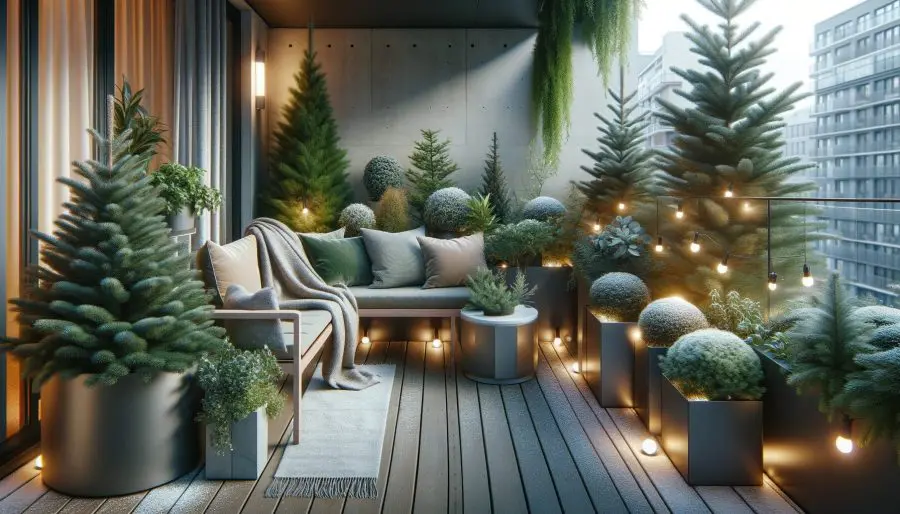
Overwintering Techniques for Balcony Plants
Winter can be a challenging time for balcony gardens, but with the right overwintering techniques, your plants can not only survive but also thrive.
Insulating Containers:
Insulation is crucial for protecting plant roots from freezing temperatures. Wrap pots in insulating materials like bubble wrap, burlap, or foam insulation.
This creates a buffer against the cold, helping to maintain a more stable soil temperature.
Consider using larger containers as they hold more soil and, consequently, more heat, offering better insulation for roots.
Indoor Overwintering Strategies:
For particularly sensitive or tropical plants, moving them indoors is often the best way to ensure their survival.
Place them in a well-lit area, away from direct heat sources like radiators.
Monitor indoor humidity levels, as dry indoor air can be detrimental to some plants.
Gradually acclimate plants to indoor conditions by bringing them in for a few hours each day over the course of a week.
Mulching for Root Protection:
Applying a layer of mulch over the soil surface can help to retain moisture and keep the roots warm.
Materials like straw, leaf mold, or bark chips are effective as mulch. This not only insulates the soil but also adds organic matter as it breaks down.
Enhancing Your Winter Balcony Garden
A winter balcony garden can be a serene and beautiful space with the right decorative touches and lighting.
- Decorative Elements for Winter Appeal: Add seasonal flair with winter-themed decorations. Consider using items like artificial snowflakes, small evergreen wreaths, or frost-resistant ornaments. This adds a festive and cheerful touch, brightening the shorter days.
- Lighting for Atmosphere: Proper lighting can transform your balcony into a magical winter escape. LED string lights are ideal for creating a cozy ambiance, draped around railings or plants. Solar-powered lamps are an eco-friendly option, offering a soft glow without the need for electrical outlets. Lanterns with candles or LED lights can be placed around the balcony for a warm, inviting atmosphere.
- Color and Texture with Winter Plants: Incorporate plants that offer color and texture in winter. Evergreens, with their rich green hues, provide a sharp contrast against the often grey winter sky. Plants with colorful berries, like winterberry holly or cotoneaster, add splashes of red and orange. Ornamental grasses, with their unique forms and textures, create visual interest and movement.
Conclusion: Embracing Winter Gardening on Your Balcony
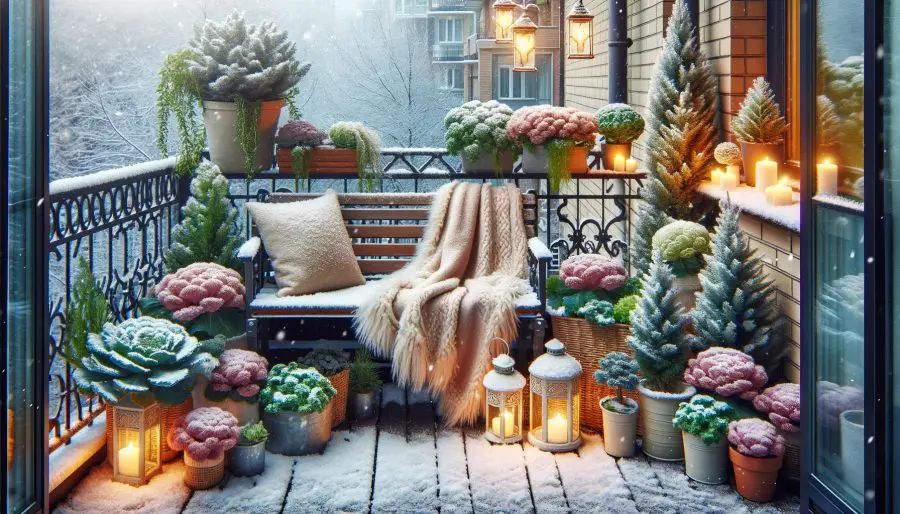
As we conclude our journey through the intricacies of winter balcony gardening, it’s important to reflect on the unique joys and benefits this season offers.
Winter gardening is not just about enduring the cold; it’s a celebration of resilience and beauty, even in the most unlikely conditions.
Here, we’ll highlight the key aspects that make winter gardening a rewarding experience.
The Beauty of a Winter Landscape:
Winter gardens have a charm of their own. The stark beauty of bare branches against a snowy backdrop, the vibrant colors of winter-blooming flowers, and the serene quietness that winter brings, all contribute to a visually stunning and peaceful garden environment.
Health and Wellness Benefits:
Gardening in winter can be incredibly beneficial for mental and physical health.
It encourages outdoor activity, even in colder months, and helps combat seasonal affective disorder (SAD) by connecting you with nature and providing a sense of accomplishment as you watch your plants thrive against the odds.
Cultivating Resilience:
Winter gardening teaches valuable lessons in resilience and adaptability.
Learning to protect and nurture your plants through harsh conditions is a rewarding challenge that can provide insights applicable to other areas of life.
Opportunity for Experimentation:
This season is an excellent time to experiment with different plants and gardening techniques.
It allows you to expand your gardening knowledge and skills, potentially discovering new favorites that thrive in cooler temperatures.
Community and Sharing:
Sharing your winter gardening experiences with friends, family, or online communities can be incredibly fulfilling.
It fosters a sense of connection and community, as you exchange tips, successes, and challenges.
Preparing for Spring:
Winter gardening also sets the stage for a flourishing spring garden.
The work you do now in caring for your plants and preparing your soil will pay off when warmer weather arrives, offering a head start on the spring gardening season.
In embracing winter balcony gardening, you’re not just maintaining a space; you’re cultivating a living, changing environment that offers beauty, joy, and a sense of continuity throughout the year.
Let the challenges of winter gardening inspire you to new heights of creativity and enjoyment in your gardening journey.


